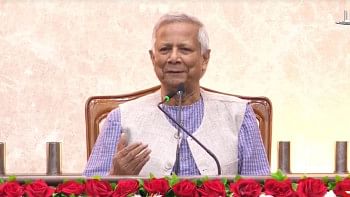WHERE LINES WENT FOR WALKS

It started with the posters covering every inch of Dhaka. Pink and white, the words “Dhaka Art Summit” were lost between the faces of political figures and slogans filled with empty promises, but the turnout at the actual event was testament to the Dhakaites' need for a welcome break in their lives.
Held at Bangladesh Shilpakala Academy from 7th to 9th February, the Summit was organised by Samdani Art Foundation. The not-for profit event featured works of artists from Afghanistan, India, Maldives, Nepal, Pakistan, Sri Lanka, and the host country, Bangladesh.
It had to be seen to be believed. Expansive galleries, tactfully placed installations and hangings, all of them lit in a warm glow for a throng of awed art lovers.

The first floor greeted you with three options. Go left and you'd be faced with a giant wooden box, its structure inside out and on display. Walk all the way around and when you enter, simple, serene white walls sit there, reflecting the blank looks of incomprehension in the visitors' eyes. Puzzled? Keep going, and you'd find a lot more.
In the adjacent room, seven LED televisions had been rotated around by 90 degrees, and fitted to the wall. Each screen showing an image of what seems to be a “roti”, slowly crumbling away; each screen showing a different instance of its rotation, the pockmarked features of the piece of bread making the entire spectacle look like the different stages of the moon. Walk away, and to the right, a series of hologram images depicting a street scene is presented. Walk past it slowly, and each panel blocks out the scene in the photograph with a splash of intensified colour, the rainbow effect burned into your memory.
Right opposite the series of photographs, 54 square canvases hang, each depicting a limb, an eye, a mouth, a head, the torso, and the legs of an immense god -- some zoomed in, some presented in an eagle eye view -- and the amalgamation of images creates a stirring in you that can't really be expressed in words. Usually, in such a case, as demonstrated by the audience at any given time, the best option is to hang back, speechless, with the mouth slightly open, before you reach for your camera-phone or DSLR to try and capture some of the magnificence you've just seen with your eyes.
From a corner of the room, a howling, wailing, but strangely beautiful music emanates from behind a black drape. Pull it aside and step in, and three massive projections joined together present themselves. Parallax is a 3D animated series of artworks by Shazia Sikander, a Pakistani-American artist and animator. With a bone chilling but hauntingly beautiful soundtrack by Du Yun, Parallax takes a look at the historical relevance of Sharjah, and is an animation like no other. To some, it was easily the highlight of the entire summit.

Curated exhibitions included B/Desh, Ex-ist, Citizens of Time, Lifeblood, Liberty, Bangladeshi Photography, and a range of individual exhibitions showcased emerging contemporaries from India, Bangladesh, and Pakistan.
Names and identities presented at the Summit included Lida Abdul, Rana Begum, Rahin Barman, Shilpa Gupta, Nikhil Chopra, Tayeba Begum Lipi, Mahbubur Rahman, Mithu Sen, Tsherin Sherpa, and Asim Waqif.
In a major art event where almost every medium, from animation to photography were presented, film and live performances could not be put aside. The experimental works of CAMP, Nikhil Chopra, Htein Lin, Bandu Manamperi, Aung Min Min, Sunil Sigdel, Arko Sumon, Nazia Andaleeb Preema and more were shown. Nikhil Chopra's Blackening VI explored issues of race and identity as he used charcoal to blacken himself over the course of an 8-hour long performance.
The speaker sessions touched on topics exploring the direction of South Asian art -- where it came from and where it is heading. Spread over three different sessions over the three days, the speaker panel included Richard Blurton, Alessio Antoniolli, Aurelien Lemonier, Anoushka Hempal, Shahidul Alam, Ayesha Sultana, Syed Jahangir and many more.
Samdani Art Foundation also announced the winner of the Samdani Art Award 2014. Ayesha Sultana bagged the award this year, from a pool of 75 contestants and 10 nominees. She is to attend a three-month-long residency programme at the Delfina Foundation in the UK, where she will work and exhibit her art.
Art has forever been a benchmark of the civility of a nation, and indicator of the intricacy and maturity of thought of its citizens. A region's art and culture defines its social and moral standpoint, and can hold up a worldview better than anything else ever can. With an aim of promoting the artistic pursuits of South Asia, Dhaka Art Summit has been playing a pivotal role in the past few years, and it will hopefully be around in the coming years as well, bringing us more of the best artists in this region under one roof.


 For all latest news, follow The Daily Star's Google News channel.
For all latest news, follow The Daily Star's Google News channel. 



Comments